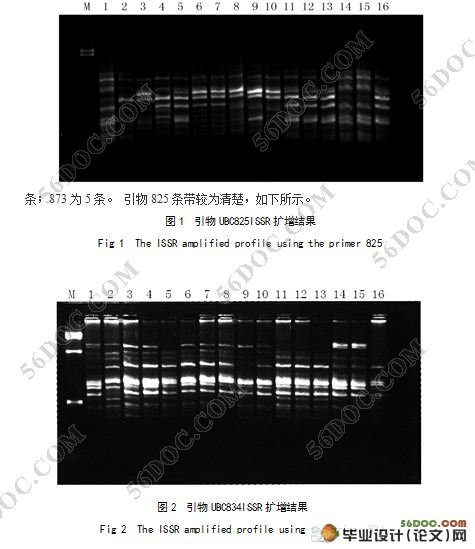湖南柑橘主要品种ISSR分析
来源:wenku163.com 资料编号:WK1634576 资料等级:★★★★★ %E8%B5%84%E6%96%99%E7%BC%96%E5%8F%B7%EF%BC%9AWK1634576
资料介绍
湖南柑橘主要品种ISSR分析(9500字)
摘 要:柑橘植物种类和类型繁多,给柑橘植物的系统学研究带来了很大的困难,在种的划分和演化关系等方面的观点也存在着较大的分歧。分子标记(Molecular Markers)是以个体间遗传物质内核苷酸序列变异为基础的遗传标记,是DNA水平遗传多态性的直接的反映,所以可以用分子标记的方法来研究柑橘属及近缘属生物型的亲缘关系。我们利用9对柑橘ISSR引物对16个湖南柑橘及野生近缘种遗传多样性检测获得了平均每个位点8个等位基因,多态性比率高达69.4%,阐明了柑橘种质资源在分子水平上存在遗传差异,为柑橘种质资源的保护提供遗传基础.
关键字:ISSR;柑橘;多态性
ISSR ANALYSES OF MAJOR CITRUS VARIETY IN HUNAN
Abstract: Many plant species and types of citrus, a systematic study of citrus plants has led to great difficulties in species classification and evolutionary relationships, etc. There is also a larger view of the differences. Molecular marker (Molecular Markers) is the genetic material between individuals within the nucleotide sequence variation based on genetic markers, DNA level is a direct reflection of genetic polymorphism, so the method can be used to study molecular markers of Citrus and related genera Biotypes related. We used 9 pairs of ISSR primers Citrus 16 Citrus Hunan and genetic diversity of wild relatives to obtain the average per locus 8 allele polymorphism rate as high as 69.4 percent, to clarify the Citrus Germplasm at the molecular level, genetic variation exists for the protection of citrus germplasm resources provide the genetic basis
Key words: ISSR;Citrus; Polymorphism

目 录
摘要•••••••••••••••••••••••••••••••••••••••••••••••••••••••••••••••1
关键词•••••••••••••••••••••••••••••••••••••••••••••••••••••••••••••1
1 前言••••••••••••••••••••••••••••••••••••••••••••••••••••••••••••2
1.1 柑橘的分类•••••••••••••••••••••••••••••••••••••••••••••••2
1.1.1 甜橙类•••••••••••••••••••••••••••••••••••••••••••••2
1.1.2 宽皮柑橘类•••••••••••••••••••••••••••••••••••••••••2
1.1.3 杂柑类•••••••••••••••••••••••••••••••••••••••••••••2
1.1.4 柚与葡萄柚类•••••••••••••••••••••••••••••••••••••••3
1.2 湖南柑橘现状•••••••••••••••••••••••••••••••••••••••••••••3
1.3 分子标记的种类•••••••••••••••••••••••••••••••••••••••••••4
1.4 ISSR 标记简介••••••••••••••••••••••••••••••••••••••••••••5
1.5 ISSR 技术的原理••••••••••••••••••••••••••••••••••••••••••6
1.6 ISSR 技术的特点••••••••••••••••••••••••••••••••••••••••••6
2 材料和方法•••••••••••••••••••••••••••••••••••••••••••••••••••••7
2.1 材料•••••••••••••••••••••••••••••••••••••••••••••••••••••7
2.1.1 药品•••••••••••••••••••••••••••••••••••••••••••••••7
2.1.2 原料•••••••••••••••••••••••••••••••••••••••••••••••7
2.1.3 仪器•••••••••••••••••••••••••••••••••••••••••••••••7
2.1.4 引物合成•••••••••••••••••••••••••••••••••••••••••••7
2.2 方法•••••••••••••••••••••••••••••••••••••••••••••••••••••8
2.2.1 DNA 的提取•••••••••••••••••••••••••••••••••••••••••8
2.2.2 引物的筛选和 ISSR-PCR 的优化•••••••••••••••••••••••8
2.2.3 凝胶电泳•••••••••••••••••••••••••••••••••••••••••••8
3 结果与分析 •••••••••••••••••••••••••••••••••••••••••••••••••••8
3.1 ISSR 引物扩增结果••••••••••••••••••••••••••••••••••••••••8
3.2 聚类分析•••••••••••••••••••••••••••••••••••••••••••••••••10
3.3 ISSR-PCR引物序列及扩增结果统计••••••••••••••••••••••••••11
4 结论•••••••••••••••••••••••••••••••••••••••••••••••••••••••••••11
参考文献 •••••••••••••••••••••••••••••••••••••••••••••••••••••••••12
致谢•••••••••••••••••••••••••••••••••••••••••••••••••••••••••••••••13
|



